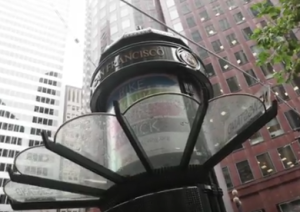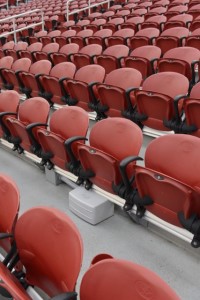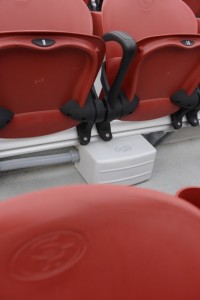Brian Mecum, vice president, network for Verizon Wireless, said in a phone interview that large amounts of wireless traffic at last year’s Super Bowl spurred Verizon to help fund a full replacement of the Levi’s Stadium DAS, which was only a year old, to make sure that this year’s big game would be able to handle the expected usage growth. Mecum said the carrier expects to see as much as 6 terabytes or more of cellular traffic during the Feb. 7 game between the Denver Broncos and the Carolina Panthers at the San Francisco 49ers’ home field in Santa Clara, Calif.
To increase capacity in the lower seating bowls, Mecum said that Verizon basically invented its own under-seat DAS antenna system and paid for its deployment, adding about “30 percent more capacity” through the under-seat antennas alone. For its Wi-Fi network, Levi’s Stadium already uses under-seat access points, as do a growing number of large outdoor arenas. While Verizon’s deployment of under-seat antennas for cellular DAS is a first we’ve heard of, it achieves the same goals as under-seat Wi-Fi, basically just getting signals closer to users in a place where there isn’t any overhead or side structures to attach antennas to.
“To get a quality signal you have to get [the antenna] closer to the device,” and the only way to do that in the 100-level sections of Levi’s Stadium is to go under the seats, Mecum said. Though stadium DAS integrator DAS Group Professionals also upgraded most of its other cellular antennas this summer throughout Levi’s Stadium, the under-seat antennas are exclusive to Verizon Wireless, Mecum said. According to DGP vice president and COO Vince Gamick, just more than 50 under-seat DAS antennas were deployed, along with more than 700 other DAS antennas in the stadium and parking lots.Low power to ease safety concerns
Though some fans might wonder about the white boxes under their seats, Mecum said the Verizon antenna deployment operates at “well below FCC standards” for power output, and should not be a cause for health concerns.
“They use about the same amount of power as a cell phone,” Mecum said. The antennas are also mounted to shoot their signals down to bounce off the concrete flooring, further reducing the power signal toward fans’ bodies.
According to Mecum, the antennas have already been doing a lot of work during the regular season — though he didn’t provide an exact number, Mecum did say that the 49ers’ home game against the rival Seattle Seahawks (which produced a lot of Wi-Fi traffic) also had a total of DAS traffic on the Verizon network that surpassed the 4.1 TB that Verizon recorded at last year’s Super Bowl at the University of Phoenix Stadium in Glendale, Ariz.
“We’re pretty excited” to see what the eventual Super Bowl DAS traffic number is, Mecum said. “We expect to see at least 1.5 times as much as we saw at the Super Bowl last year.”

San Franicso advertising kiosk where Verizon Wireless installed extra antennas for Super Bowl crowds. Photo: Screen shot from Verizon Wireless video
Antennas on kiosks, and engineering for the Lombardi Trophy traffic
The stadium improvements are just part of a Bay area-wide infrastructure improvement blitz from Verizon, a fairly typical thing ahead of big events for almost all the cellular carriers. But some of the pre-game prep for Verizon has a unique flavor for San Francisco, especially the carrier’s decision to put small cells inside San Francisco’s stylish advertising kiosks that dot the downtown area.
With Super Bowl fan activities taking place from San Francisco’s Ferry Building down to the Moscone Convention Center, Mecum said the kiosks became a perfect place to add cellular capacity.
“They were basically empty [at the top] so we ran fiber to them and put in antennas,” Mecum said.
Verizon’s Super Bowl engineering effort also included extra antenna deployments around the areas where the Super Bowl hardware, the Lombardi Trophy and the Super Bowl winning teams’ rings, will be on display.
“The lines to see the trophy and the rings are so long we actually needed to engineer for them and adjust the antenna density [in the display area],” Mecum said. “So you should be able to connect anywhere and everywhere you go for the Super Bowl.”








